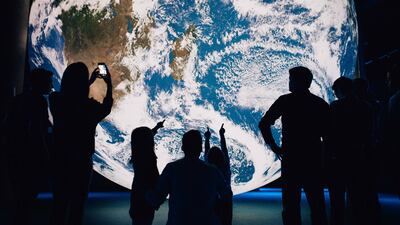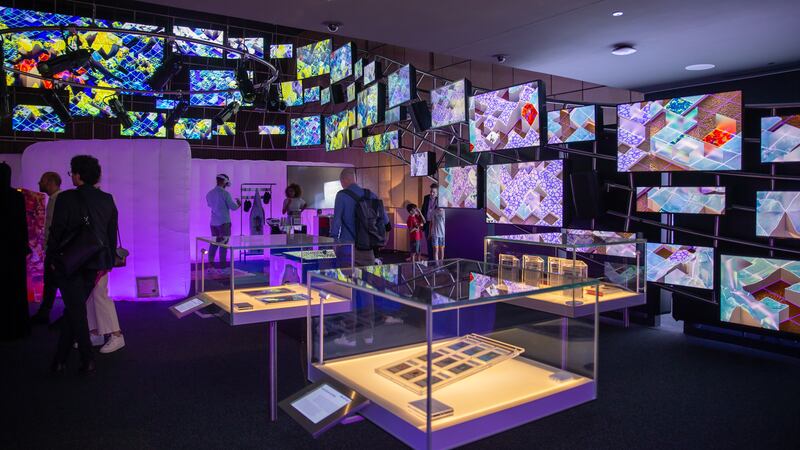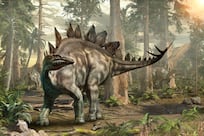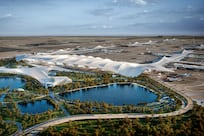The metaverse is almost here, whether you understand it or not.
The growth, potential and intrigue of this cyberspace is part of an infinitely expanding digital landscape, one that will affect our physical reality in some ways we might be able to predict and others we still don’t understand.
The Media Majlis at Northwestern University in Qatar attempts to make sense of the concepts and realities with their latest in-depth exhibition titled MetaWhat?
“If someone told you 10 years ago that those digital cameras we took to social gatherings would become all but obsolete, would you have believed them?” Jack Thomas Taylor, curator at the Media Majlis, asks The National.
“If they told you that you would take photos on your phone and store them in the 'cloud', you might have laughed. The same is true now for digital assets. It is how we will express ourselves, connect with others and build our reputation.”
The metaverse – and by extension digital art – is a crucial means of understanding how contemporary society and future generations will express, communicate and archive their ideas, thoughts and experiences.
Through five thematic installations – which include digital screens, hologram NFT displays, virtual and augmented reality, interactive elements, avatar personalities and rare and valuable physical collectibles – the exhibition will explore different facets of the metaverse.
The completely bilingual exhibition not only takes on the magnitude of what the metaverse is and how it can operate, but also makes a point to do so from the perspective of the Arab world and the Global South.
Taylor elaborates that exploring and opening dialogue on the metaverse through this lens is crucial since it has great potential to create and push particular narratives.
“If we don’t inspire, excite and have an open conversation, we will unfortunately have to conform to a digital landscape that is built, developed and operated by western technology giants,” Taylor says.
“If we don’t inject ourselves into the process of creation and protect the idea of decentralisation, then we will end up with another form of authority controlling and manipulating the public, as we now see on social media platforms and search engine algorithms, for example.”
The aim of MetaWhat? is to go beyond what is already known from the hype, such as the confusion surrounding the metaverse, by taking a more critical route into the context, means and future of this coming experience of digital expression.
The exhibition does this by first starting at a point that would be familiar to most audiences. Whether through avatar personalities or gaming titles such as Fortnite, different sections of the exhibition introduce visitors into the works in familiar ways before guiding them into different layers of the metaverse with geographically appropriate examples.
Visitors can explore the concept of a fragile home across the Naqab desert and what is now the Occupied Palestinian Territories, through Remember this place 31°20’46”N 34°46’46”E, a virtual reality experience produced by The Media Majlis and Northwestern Qatar.
Also showing will be an version of Gaia, a touring artwork by British artist Luke Jerram, measuring six metres in diameter with detailed Nasa imagery of the Earth’s surface, which is accompanied by a specially made surround-sound composition by Bafta-award-winning composer Dan Jones.

Gaia was included in the exhibition to make the public can think about how the virtual and physical worlds are fusing.
“At 2.1 million times smaller than the real Earth, Gaia provides viewers the opportunity to see our planet floating in three dimensions,” Taylor says.
“The reason it has been included in this exhibition is to prompt visitors to ask tough questions about how the metaverse could impact our physical existence. How can we start talking about virtual worlds when we can’t even see our own planet? It also makes us question the environmental impact these new technologies are having on our fragile planet.”
Conceptualising and coming to terms with what the metaverse truly means for the future, and how it is already part of our present, is a multifaceted conversation.
“The very fact that we took the opportunity to theme an exhibition about the metaverse in Qatar is already one step closer to hosting conversations from the perspective of this part of the world,” Taylor adds.
“If we don’t include this content, then how can we expect any other museum to include this?”
MetaWhat? will be running The Media Majlis at Northwestern University in Qatar until December 7







